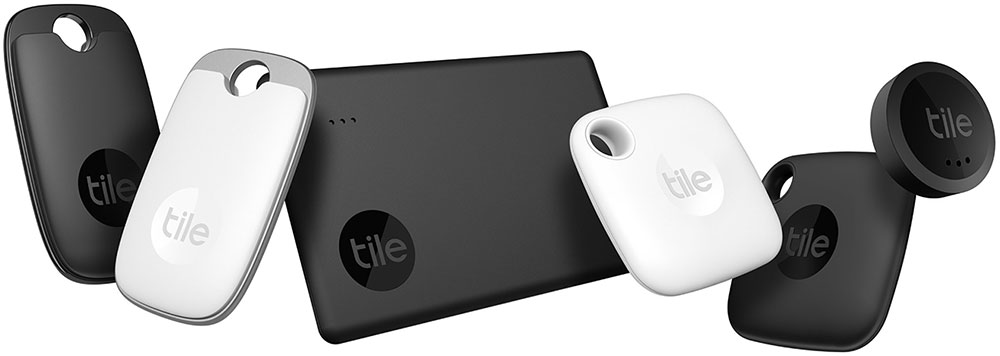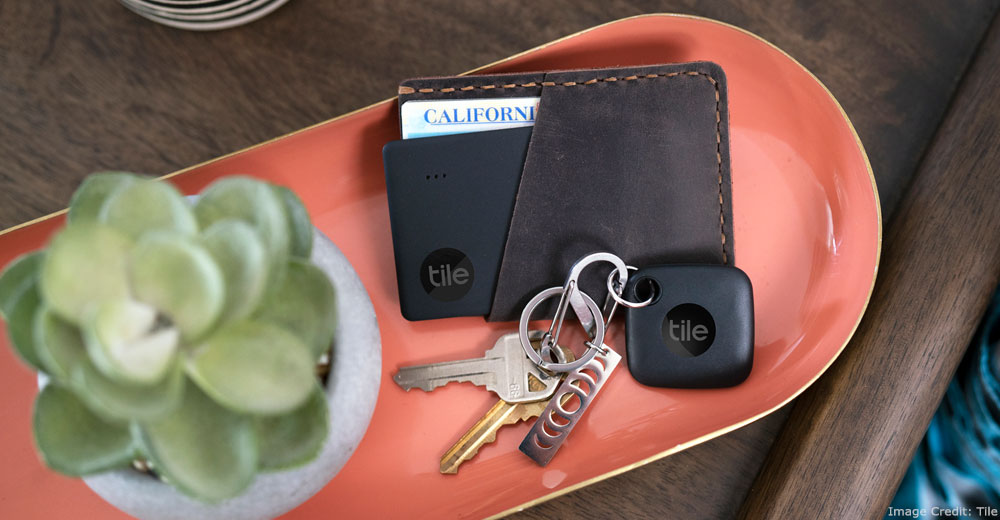Item tracker maker Tile refreshed its product line Tuesday and announced it will be introducing a new ultra-wideband (UWB) product in 2022.
The refreshed lineup looks like this:
- The Pro (US$34.99), Tile’s most powerful tracker with a 400-foot range and a redesign to look like a key fob;
- The Mate ($24.99), Sticker ($29.99) and Slim ($34.99) now have a range of 250-feet and a louder ring so whatever they’re attached to is easier to find;
- The Mate now has a three-year battery life; and
- All four units have been upgraded to an IP67 water-resistance rating, meaning they can be submerged in one meter of water for up to 30 minutes.

(Image Credit: Tile)
In addition, all the models, except the Sticker, support Tile Lost and Found. It allows anyone finding a Tile tag to scan a QR code on the back, see who it belongs to and arrange for a reunification with its owner.
“We built this category nearly a decade ago, and since then we’ve been listening to our customers and evolving our products to meet their specific needs,” Tile CEO CJ Prober said in a statement.
“People are busier than ever, and our customers depend on our products to eliminate the stress of endlessly searching for lost or misplaced items, especially around the home, which is a nuisance that happens daily for many of us,” he explained.
“With a longer finding range, louder ring and voice-enabled finding through Amazon Alexa and Google Assistant, we’re making it even easier for people to quickly find what they need,” he added.
Ultra Tag
The company also announced the Tile Ultra, which it expects to reach the market in 2022. Ultra combines Bluetooth and UWB technology for a more precise finding experience and includes augmented reality (AR) software to make it easier to find items behind shelves or in a noisy restaurant.
Tile CTO Steve Klinkner explained that UWB and Bluetooth work best together.
“Bluetooth offers a longer finding range to get you near your Tile, while UWB offers highly precise directional finding to get you directly to your lost item,” he told TechNewsWorld.
“The AR software makes the finding experience much more visual, so you can easily find your item using directional arrows and distance and see exactly where your item is within your environment,” he continued.
“It also allows you to find without the use of sound, which works well if you’re in a loud restaurant, don’t want to wake the family or are hearing impaired,” he added.
A lot of attention is being paid to the Ultra model, noted Mark N. Vena, president and principal analyst at SmartTechResearch, a technology advisory firm in San Jose, Calif.
“That’s understandable,” he said. “It’s their first ultra-wideband solution, and that’s where the market is going.”
“Tile has clearly worked to expand the value of their offerings, however many of the biggest developments will not be available until 2022,” added Jonathan Collins, a research director with ABI Research.
“That said though, the combination of greater range and greater precision with UWB tackles Apple and Samsung head-on,” he told TechNewsWorld, “while AR provision could help make their offering more intuitive and set the devices apart.”
Tackling Apple and Samsung
With UWB Tile tackles the key advantage Apple and Samsung have had this year, Collins explained.
“What is unique to Tile’s offerings — and will continue to be — is the ability to offer its tags to both the Apple and the Android install base; far expanding the addressable market for Tile tags,” he said, “while its major competitors keep their tags locked to use by their existing device customers.”
“In addition, Tile has a wider range of tag formats and designs to appeal to different applications at varying price points,” he added.
Apple may have an edge now over Tile in the smart home by integrating its tags with HomeKit and its UWB enabled HomePod mini.
However, Collins noted that Tile is not neglecting the space. “It supports integration with Google Assistant and Amazon Alexa as well so it has the potential to help inform a wide range of smart home systems,” he said.
“In addition,” he continued, “Tile is also working with Amazon’s Sidewalk technology to further extend its potential tracker range — although that remains further out.”
Focus on Privacy
Also in 2022, Tile announced it will be rolling out a new Scan and Secure feature to improve the privacy of its devices. It will enable anyone with the Tile app — even if they don’t have an active Tile account — to easily scan for and detect nearby Tile devices and identify if an unknown device is near them.
Park Associates President Elizabeth Parks noted that earlier this year, Samsung added a similar feature to its SmartThings platform.
“Unknown Tag Search can identify any unknown SmartTags that might be located in your general area or that might be moving along with you,” she told TechNewsWorld.
“Once the unknown SmartTag is identified, the user is able to remove it,” she explained. “This SmartTag update minimizes the device’s ability to track other people. Specifically, other SmartTag owners.”
Adam Wright, the smart home research analyst at IDC, noted that tracking devices are stoking new privacy fears about people using the tracking devices to secretly keep an eye on friends, family, spouses, neighbors, and others.
“Tracker makers need to continue to develop tools to protect privacy and minimize opportunities for nefarious use,” he told TechNewsWorld. “Tile’s Scan and Secure feature — and Apple and Samsung’s similar technologies — are a great first step towards this goal.”
“With any technology,” Klinkner added, “it’s important privacy is baked into the company’s philosophy and is something that’s always being evaluated for possible enhancements.”
“At Tile,” he continued, “we have a Privacy Council that regularly meets to ensure we’re looking at privacy from all angles and continuing to make it a top priority.”
Hot Market
According to Mordor Intelligence, the global smart tracker market will be expanding at a 12.4 percent annual clip, growing from $413.14 million in 2019 to $807.66 million by 2025.
“Trackers have been around for many years, but have only become more broadly popular among mainstream consumers in recent years, thanks in large part to extensive marketing campaigns and product advancements by Apple, Samsung, and now Tile,” Wright said.
“The tracker market has long been a solid market, with Tile shipping north of 35 million tags over the past decade as well as seeing its technology embedded in a range of partner devices, but there is no doubt that Apple and Samsung’s engagement in the market has raised greater awareness, revenues and investment this year,” Collins added.
“The $40 million in funding Tile completed last month was earmarked for developing products to tackle Apple head on and this roadmap does much of that,” he added.












































